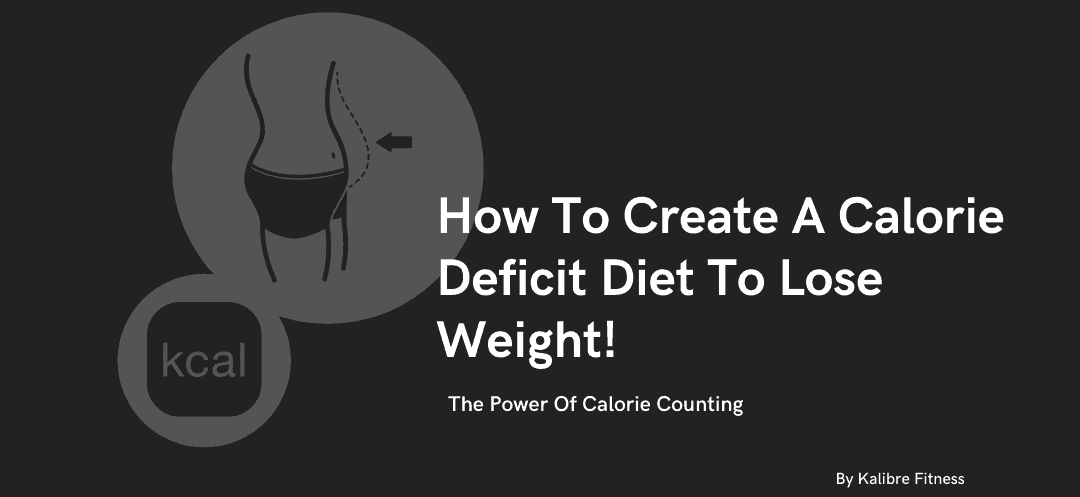Today’s post will teach you how to create a calorie-deficit diet to guarantee those excess pounds are quickly shed.
I have been bodybuilding for 2 years now, cycling between bulking (gaining muscle and fat) and shredding (losing fat). I know how hard it can be to get rid of unwanted fat!
But it doesn’t have to be!
Read on to learn how to create a calorie-deficit diet by calorie-counting the foods you eat. This skill, once learned and applied, will produce long-term fat loss results for life! There are also 6 bonus tips at the end!
Are you ready?
Let’s go!
What Are Maintenance Calories?
First, let’s understand the principle of “Maintenance Calories”.
The body consumes energy 24/7. When we go to work, we consume energy. When we exercise, we consume MORE energy (usually). Even when we are sleeping, we are consuming energy. T
his energy is provided by calories in the food we eat.
Calories fuel the physiological and biochemical processes which keep the body alive and operating. This is called the basal metabolic rate (or BMR).(1)
“Maintenance Calories” simply refers to the number of daily calories required to maintain our BMR and fuel everyday activities (working, exercising, doing housework, playing with the kids, and everything else).
When we hit our maintenance calories, body weight remains the same.(2)
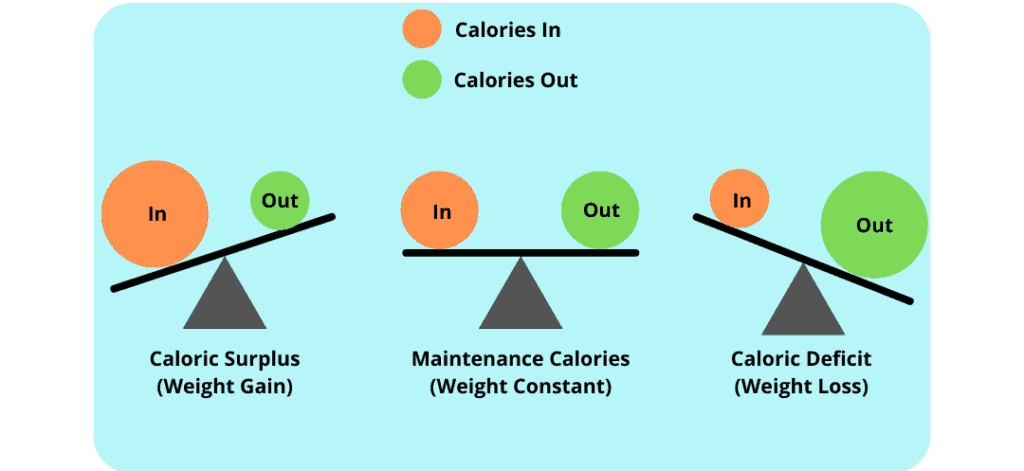
Exceeding our maintenance calories leads to a calorie surplus and body weight increases. Going under our maintenance calories leads to a calorie deficit and bodyweight decreases).(1)
We will now explain how to choose an appropriate caloric deficit and how to build your diet to achieve your required calorie target
But before we do that, you may be asking:
“What is the EXACT figure for my maintenance calories?”
Determining Your Maintenance Calories
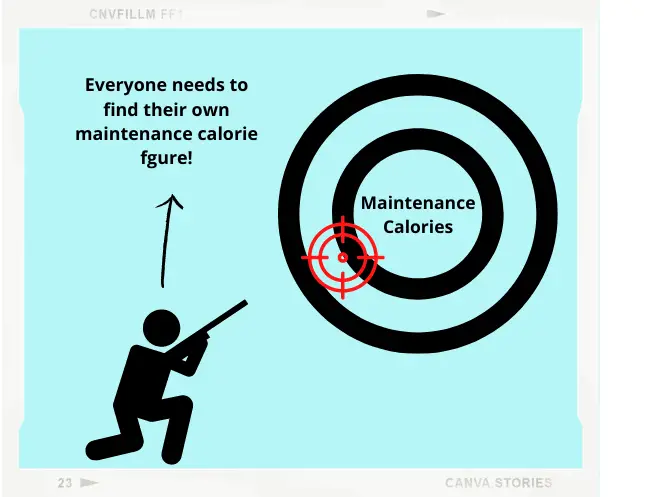
Daily recommended daily calorie intakes are widely published.
They are usually quoted as ~2500 calories for men and ~2000 calories for women. But notice these figures are simply RECOMMENDED for the general population. These numbers are in fact too general for our goal today.
In reality, everyone has a very different daily maintenance calorie intake. The number varies with individual age, height, gender, genetics, BMR, body composition, and daily activity levels.
Online charts and calculators will provide reliable figures to work with. These online tools are free to use, and allow individuals to calculate their own daily maintenance calories.
Calculating Your Daily Maintenance Calories
Provide a more precise ballpark figure than the recommended daily calorie intake.
Provide the most precise figure according to your personal factors.
Once we have established our maintenance calorie intake, we can establish a calorie deficit.
In other words, how many calories would you like to be below maintenance to lose weight?I
Understanding Types Of Calorie Deficits
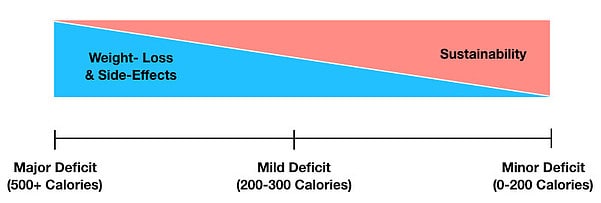
Calorie deficits come in different magnitudes. They are defined by their deficit size (minor, moderate, major). Each deficit size will produce different degrees of weight loss and side effects (e.g. tiredness, fatigue, irritability, and insomnia).(3)
Calorie Deficits
Minor deficits (0-200 calories) – weight loss at ~0.5 pounds/week, minimal side effects.
Mild deficits (200-500 calories) – weight loss at ~1 pound/week, moderate side effects.
Major deficits (500+ calories) – weight loss at ~2+ pounds/week, major side-effects.
When deciding on a calorie deficit, consider not only how much weight you would like to lose, but your tolerance to side effects.
It is not uncommon for people to lose significant weight on a major calorie deficit, only to crash and binge afterward. This is because the side effects make the diet unsustainable.(4)
All the handwork becomes lost in vain!
I would always recommend starting with a light/mild calorie deficit of ~300 calories. This will provide noticeable weight loss results (~0.6 pounds/week) whilst minimizing the side effects.
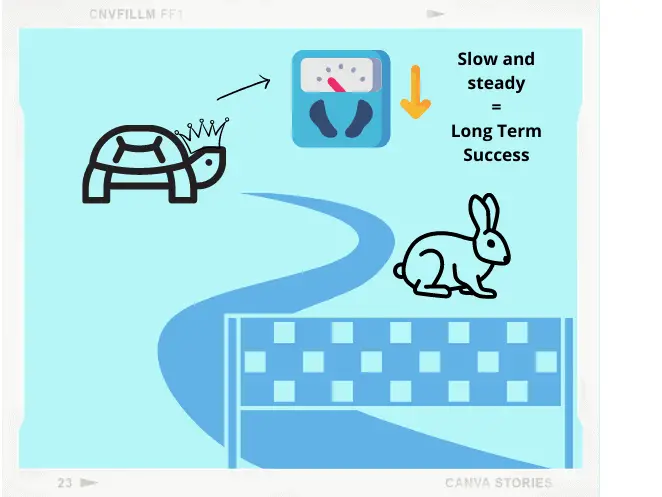
Remember, weight loss should be a marathon, not a sprint. Be the tortoise, not the hare! This will set you up for long-term success in maintaining your desired weight.
Now that you know your maintenance calories and deficit calories, you can establish your daily target calories. In other words, how many calories you are aiming to consume every day to lose weight?
Establishing Your Daily Target Calories
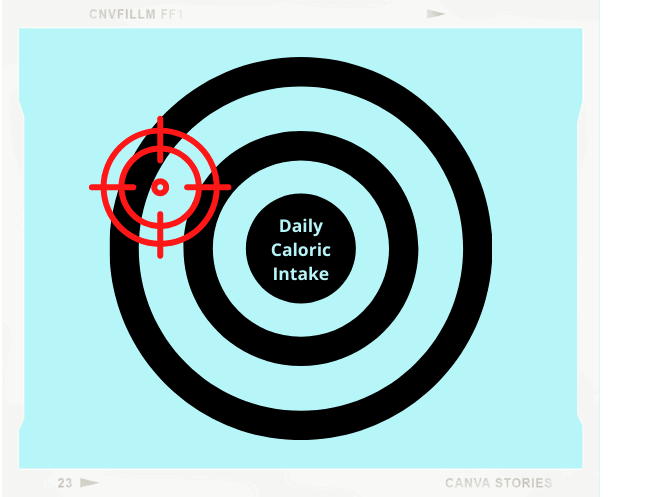
So far, we have determined our daily maintenance calories and calorie deficit. To determine your daily target calories, apply your numbers to the formula below.
Formula: Target Calories
Target Daily Calories = Daily Maintenance Calories – Calorie Deficit.
If we pretend your daily maintenance calorie intake is 2350 calories, and you wish to lose weight on a 300-calorie daily deficit, then your target daily calorie intake is 2050 calories (2350 – 300)
In other words, you would aim to consume 2050 calories each day, throughout the entire day. This will result in ~0.6 pounds of weight loss per week.
But how do you hit your target calories? How do you ensure you don’t overconsume?
An effective method called “Calorie Counting” is your friend. Invest time to learn this method, and you will find weight management to be much easier in the future!
Calorie Counting Your Foods
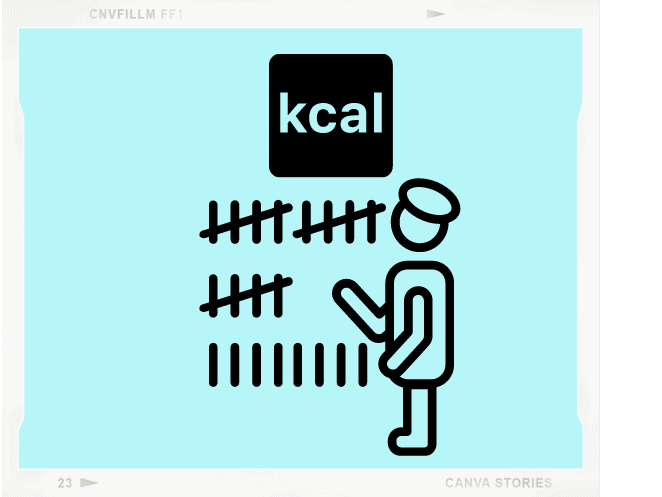
Calorie counting is simply the process of recording the total number of calories you consume throughout the day.
This involves recording and adding the calories in each ingredient of every meal and every snack. The goal is to not exceed your daily calorie target.
Before you can calorie count, you will need a set of kitchen scales measuring in grams. So go on Amazon and pick one up. It will be an investment for life!
Next, we will be calorie-counting chicken breast as an example.
Once you understand the calorie counting process, you can apply the same principle to count each ingredient in a meal.
Determining Food Weight Required For A Calorie Target
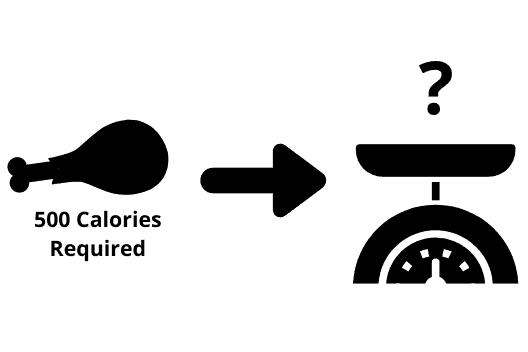
When aiming to hit a calorie target, it’s very useful to be able to determine how much of an ingredient is required to hit a specific number of calories.
Example: How much chicken shall I grill for lunch to ensure the lunch hits 500 calories?
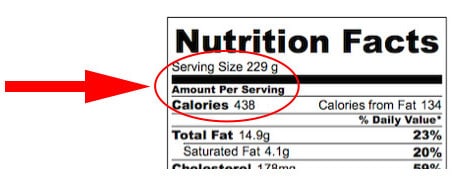
Most ingredients come with a nutrition label. The label is typically found stuck to the back of the packaging. It will provide you with the essential numbers.
The label informs us that 229g of chicken breast contains 438 calories. We will call this the “label reference weight” and “label reference calories”.
Let’s pretend you would like the grilled chicken breast to provide 500 calories (“desired calorie amount“) out of the daily target of 2050 calories.
How much chicken do you need to grill?
Simply plug the numbers into the formula below:
Formula: Food Weight Required For Specific Calories
Required Ingredient Weight = Desired Calorie Amount ÷ Label Reference Calorie x Label Reference Weight
When we plug in the numbers for our chicken breast example, it looks like this:
Required Chicken Breast Weight = 500 calories ÷ 438 calories x 229 grams
The formula tells us that 261 grams of chicken breast would provide a 500-calorie lunch!
Determining Calories In A Set-Amount Of Ingredient
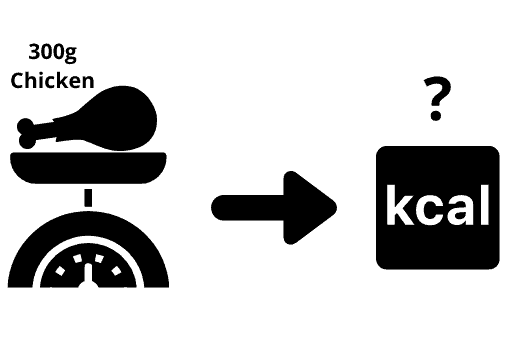
Other times, you have a specific amount of an ingredient you would like to consume. It’s useful to be able to determine how many calories are in that particular ingredient.
Example: one large chicken breast is left over in the packaging. It expires today and needs to be consumed immediately. How many calories are you consuming?

The same chicken breast label informs us that 229g of chicken breast contains 438 calories. But how many calories are in this one large chicken breast (let’s pretend it weighs 300g)?
Simply plug the numbers into the formula below :
Formula: Calories In A Set-Amount Of Ingredient
Ingredient Calorie Amount = Ingredient Weight ÷ Label Reference Weight x Label Reference Calories.
When we plug in the numbers for our chicken breast example, it looks like this:
Chicken Breast Calorie Amount = 300 grams ÷ 229 grams x 438 calories.
Therefore, that 300-gram chicken breast will contain 574 calories!
Tip: Not all ingredients come with a nutrition label (e.g. loose fruit and veg). But you can use a variety of free online food nutrition databases. Google contains nutritional information on millions of ingredients. Simply search “ingredient + nutritional info”.
Creating Your Calorie-Deficit Diet
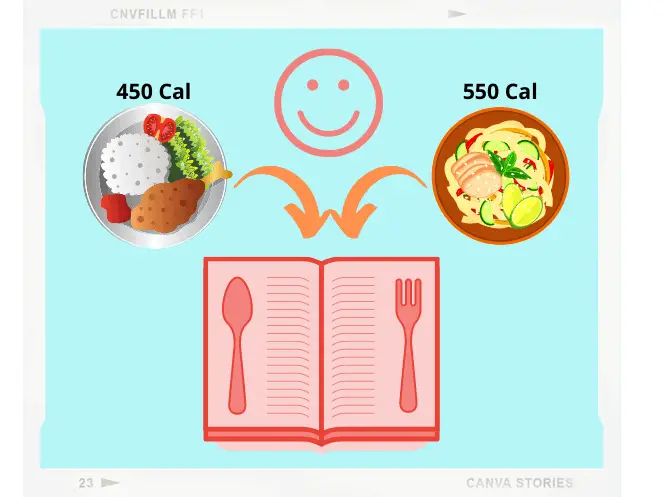
Now you know how to calorie count your ingredients, you can plan a calorie deficit diet that will guarantee weight loss!
Try spending some time creating a daily set menu.
Plan each of your daily meals with the exact weights and measurements of each ingredient. When the time comes for you to cook the meal, you know exactly how much of each ingredient to use and exactly how many calories you are consuming throughout the whole day.
Continue cooking the same set menu each day of the week. This will ensure a consistent calorie deficit throughout the week with minimal fuss. You can always change the menu every week.
For meal ideas, check our guide to creating an effective diet plan.
6 Tips For Calorie-Deficit Dieting Success
Calorie counting requires time and effort to learn.
The initial learning curve may be steep, but it’s a skill you will keep for life. Do not be disheartened if your first attempt does not produce weight loss results.

After a year of calorie counting, I am now able to estimate the calories in my food. This allows me to maintain my weight without having to over-analyze the numbers.
And I know you can do it too!
Here are 6 tips and pitfalls to watch out for during your calorie-counting journey.
1. Meal Preps!
Cook your calorie-counted meal at home and take them to the office in a Tupperware container. This means you don’t have to eat unknown calories from the office cafeteria.
2. Batch Cook!
Cook a big batch of food and calorie count the entire batch. Then portion your meals into Tupperware containers. Divide the total batch calories by portion number to establish how many calories are in each meal container.
Now you have conveniently calorie-counted meals ready to heat up when you need them!
I like to do this with chili, bolognese, and stews and freeze them for another time.
3. Regular Meals!
Aim for 4+ meals evenly spaced throughout the day. Each meal should contain 300-600 calories. This will keep you satiated throughout the day whilst keeping your metabolism burning.
Avoid consuming more than 600 calories for any given meal.(5)
4. Record Your Recipes!
If you enjoy cooking, this can be strangely enjoyable. Regardless, make sure to record the caloric details of all your recipes. This will allow you to quickly access calorie-counted recipes which you know you will love!
5. Hidden Calories!
Try to be as detailed as you can in your calorie count. Record everything. This includes cooking oils, dressings, and sauces. These are often calorie-rich. They are common reasons why many people fail in their diet.(6)
6. Snacking Is OK!
Snacking is ok during a diet. In fact, it can be psychologically beneficial to snack. But make sure you account for all the calories in your snacks. As with everything in life, moderation is key.
Conclusion
That’s it!
Now you know how to create a calorie-deficit diet, and how to calorie count your foods to ensure you consistently hit your caloric targets every day. You can also use our 6 great tips to help you succeed in your diet, and lose weight!
Calorie counting is an extremely powerful tool in your arsenal to combat weight loss. If you spend time learning the method and applying it, weight loss is GUARANTEED.
A diet should also be combined with an exercise program to SUPERCHARGE fat loss. Check out our guide on weightlifting to lose fat for inspiration!
Have you tried calorie counting yet? How did it go for you?
Feel free to send me a message if you have any questions! You can find my details on the “contact us” page.
You may also be interested in the downloadable Kalibre Blueprint PDF which details exactly how I gained 40lbs of lean muscle (it’s 100% free!). It details the exact exercises and nutrition (with printable worksheets) I used to go from skinny to ripped!
Thanks for reading guys!
Peace Out,
Kal
(Biochemistry BSc, Biomedical Sciences MSc, Ex-Skinny Guy)

